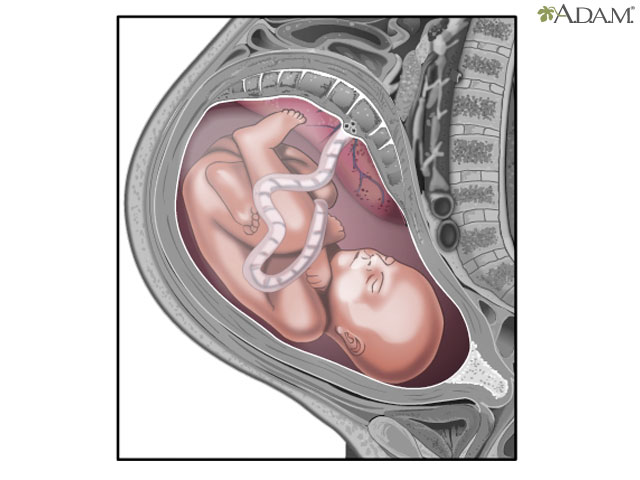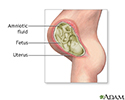Amniotic fluid
Amniotic fluid is a clear, slightly yellowish liquid that surrounds the unborn baby (fetus) during pregnancy. It is contained in the amniotic sac.

While in the womb, the baby floats in the amniotic fluid. The amount of amniotic fluid is greatest at about 34 weeks into the pregnancy (34 weeks gestation), when it averages 800 mL. About 600 mL of amniotic fluid surrounds the baby at full term (40 weeks gestation).
The amniotic fluid constantly moves (circulates) as the baby swallows and "inhales" the fluid, and then releases it.
The amniotic fluid helps:
- The developing baby to move in the womb, which allows for proper bone growth
- The lungs to develop properly
- Prevent pressure on the umbilical cord
- Keep a constant temperature around the baby, protecting from heat loss
- Protect the baby from outside injury by cushioning sudden blows or movements
Too much amniotic fluid is called polyhydramnios. This condition can occur with multiple pregnancies (twins or triplets), congenital anomalies (problems that exist when the baby is born), or gestational diabetes.
Too little amniotic fluid is known as oligohydramnios. This condition may occur with late pregnancies, ruptured membranes, placental dysfunction, or fetal abnormalities.
Abnormal amounts of amniotic fluid may cause the health care provider to watch the pregnancy more carefully. Removing a sample of the fluid through amniocentesis can provide information about the sex, health, and development of the fetus.
References
Burton GJ, Sibley CP, Jauniaux ERM. Placental anatomy and physiology. In: Landon MB, Galan HL, Jauniaux ERM, et al, eds. Gabbe's Obstetrics: Normal and Problem Pregnancies. 8th ed. Philadelphia, PA: Elsevier; 2021:chap 1.
Gilbert WM. Amniotic fluid disorders. In: Landon MB, Galan HL, Jauniaux ERM, et al, eds. Gabbe's Obstetrics: Normal and Problem Pregnancies. 8th ed. Philadelphia, PA: Elsevier; 2021:chap 28.
Ross MG, Beall MH. Amniotic fluid dynamics. In: Lockwood CJ, Copel JA, Dugoff L, et al, eds. Creasy and Resnik's Maternal-Fetal Medicine: Principles and Practice. 9th ed. Philadelphia, PA: Elsevier; 2023:chap 4.
Review Date: 11/10/2022










